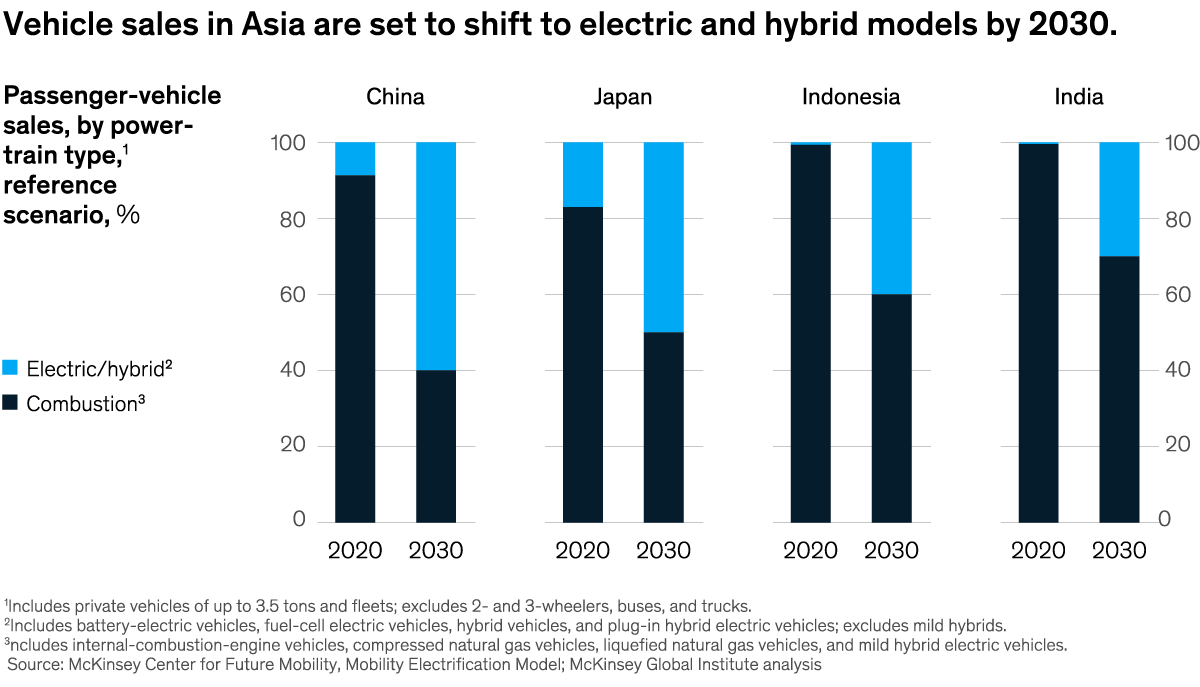Archives
- By thread 5363
-
By date
- June 2021 10
- July 2021 6
- August 2021 20
- September 2021 21
- October 2021 48
- November 2021 40
- December 2021 23
- January 2022 46
- February 2022 80
- March 2022 109
- April 2022 100
- May 2022 97
- June 2022 105
- July 2022 82
- August 2022 95
- September 2022 103
- October 2022 117
- November 2022 115
- December 2022 102
- January 2023 88
- February 2023 90
- March 2023 116
- April 2023 97
- May 2023 159
- June 2023 145
- July 2023 120
- August 2023 90
- September 2023 102
- October 2023 106
- November 2023 100
- December 2023 74
- January 2024 75
- February 2024 75
- March 2024 78
- April 2024 74
- May 2024 108
- June 2024 98
- July 2024 116
- August 2024 134
- September 2024 130
- October 2024 141
- November 2024 171
- December 2024 115
- January 2025 216
- February 2025 140
- March 2025 220
- April 2025 233
- May 2025 239
- June 2025 303
- July 2025 176
-
Urban transit in the postpandemic age
McKinsey&Company
Drive less, ride more .

The future of urban transit The news • Out of the fast lane. As the largest generation in the US, millennials are starting to influence an aspect of infrastructure that hasn’t changed much in the past 50 years: transportation planning. A recent study found a widening generation gap in driving habits, with millennials driving less than both Gen X and baby boomers. Millennial city dwellers tend to walk, bike, or use public transit. They’ve also had less of a need to go out, thanks to remote work and online shopping. [Quartz] • Wheels on the bus. In the US, public transit has typically best served commuters working a regular 9-to-5 schedule, but those aren’t the riders who have stuck around. When ridership fell steeply during the pandemic, transit officials realized they should focus on the people who most rely on subways and buses: communities of color, lower-income residents, and people who don’t own cars. Some city transit agencies have made changes to better serve these populations—for example, adding more off-peak service or reducing or eliminating fares. [Wired] 
“Riders may soon be trading expectations of safety for expectations of convenience, efficiency, and reliability.” 
Our insights • In the open air. Traveling in open air has been booming during the pandemic, observe two executives from ridesharing companies Uber and Via in a joint interview. They point to the expanding bike “superhighways” of Berlin and London as evidence of cycling’s rising popularity. In the future, they say, expect “a permanent redistribution of street space from cars to people, in the form of new sidewalks, bike lanes, and green spaces,” with car-free greenways and shared streets becoming “lasting fixtures of the urban landscape.” • The 15-minute city. In the next five years, some big cities will “take steps to roundly reject the private car as a major component of urban mobility,” predicts one of the executives. Already, in Barcelona, car-free “superblocks” give pedestrians free rein of nine-block neighborhoods. Paris is pursuing the “15-minute city” model, where everything a resident needs is 15 minutes away on foot or by bike. Read our interview for perspectives on how new trends could change the urban-mobility landscape. — Edited by Gwyn Herbein See the road ahead 
Was this forwarded to you? Sign up here. Or send us feedback — we’d love to hear from you. 

Follow our thinking 


This email contains information about McKinsey’s research, insights, services, or events. By opening our emails or clicking on links, you agree to our use of cookies and web tracking technology. For more information on how we use and protect your information, please review our privacy policy. You received this email because you subscribed to the On Point newsletter. Manage subscriptions | Unsubscribe Copyright © 2022 | McKinsey & Company, 3 World Trade Center, 175 Greenwich Street, New York, NY 10007
by "McKinsey On Point" <publishing@email.mckinsey.com> - 10:14 - 24 Jan 2022 -
Happening Soon! Register for Sumo Logic's Live Demo Series
Sumo Logic
Sumo Logic Live Demos
 Hello Mohammad,
Hello Mohammad,
Don’t miss this live demo and Q&A series on mastering your data! All demos are 30 minutes with a live Q&A. See the features you want to use in action and get instant answers to your questions.
Cloud Security Monitoring and Analytics, January 27th at 12pm AEST Companies generate data at an exponential rate, and the task of analyzing customer data to produce relevant security analytics insights can be overwhelming. The Sumo Logic cloud-native platform provides granular visibility at cloud scale that empowers your team to prioritize and investigate security insights within your infrastructure. Register Cloud SIEM, January 28th at 12pm AEST Sumo Logic’s Cloud SIEM solution provides security analysts with enhanced visibility to seamlessly monitor their organisation’s on-prem, hybrid, and multi-cloud infrastructures. By collecting and automatically correlating all of their data, Sumo Logic’s Cloud SIEM detects threats and enables SOC teams to thoroughly understand the impact and context of an attack. Register Application Observability, February 1st at 12pm AEST Demand for faster innovation and efficiency is driving organisations to accelerate application modernisation creating additional challenges on how to manage their reliability. Sumo Logic’s observability solution gives site reliability engineers operational visibility across the entire stack, with entity-driven correlations and actionable insights from your applications to your infrastructure. Register Software Development Optimization, February 2nd at 12pm AEST Boost your software development lifecycle with Sumo Logic’s solution created to help teams build better software faster. The Software Development Optimization solution is designed to collect and correlate data across the entire software development process and DevOps toolchain to help teams continuously improve how they deliver software. Register Cloud SOAR, February 3rd at 12pm AEST Sumo Logic’s Cloud SOAR boosts the effectiveness of security analysts by providing automated real-time incident management responses, immediate and customisable incident reports, and invaluable insights regarding incoming alerts, ultimately enhancing the accuracy and speed at which SOC teams respond to threats. Register Sumo Logic, Level 9, 64 York Street, Sydney, NSW 2000
© 2022 Sumo Logic, All rights reserved.Unsubscribe 


by "Sumo Logic" <marketing-info@sumologic.com> - 07:01 - 24 Jan 2022 -
5 trends shaping global sporting goods in 2022: Download a free report to get ahead of the game
the Daily read
Read the report .
Share this email 



AN ARTICLE A DAY, PICKED BY OUR EDITORS 
How are sporting goods like Coco Chanel? According to the founder of a running-shoes company, in the past two years the global industry has seen a major shift, “comparable to the 1920s when [Chanel] liberated women from corsets.” A new report, from the World Federation of the Sporting Goods Industry and McKinsey, reviews the market and dives deeper on five trends that could reshape it in 2022, including social commerce and sustainability. Read the executive summary or download the full report for free to get smart and stay ahead of the game. — Torea Frey, managing editor, Seattle 
Sporting goods 2022: The new normal is here The sporting-goods industry continues to evolve amid increased health awareness, shifting channel preferences, and rising sustainability concerns. Sporting-goods players need to adapt to five trends shaping the industry in 2022. Read the report 

Quote of the Day “The level of stress that individuals are dealing with is going to have massive implications on everyone’s well-being, which then will put more strain back on the healthcare system.” —Gretchen Berlin, registered nurse and senior partner, in a new episode of The McKinsey Podcast on nursing and the great attrition 
Chart of the Day See today’s chart 
Also New 

How to prepare for a sustainable future along the value chain Consumer-goods companies are setting ambitious sustainability targets for themselves. To reach those targets, however, changes are required along the entire value chain—with a concrete road map. Take a holistic approach 


Want to drive inclusive economic growth? Start with manufacturing The decline of the US manufacturing industry has contributed to rising inequality and hurt the country’s global competitiveness—a revitalization could contribute to sustainable and inclusive growth. Restore competitiveness 


From speech to insights: The value of the human voice In a digital age, live voice contacts matter even more in providing a high-quality customer experience. New technologies make voice-data analysis easier to achieve, for lasting results. Speak with intention 


Follow our thinking 



Share these insights Did you enjoy this newsletter? Forward it to colleagues and friends so they can subscribe too.
Was this issue forwarded to you? Sign up for it and sample our 40+ other free email subscriptions here.This email contains information about McKinsey’s research, insights, services, or events. By opening our emails or clicking on links, you agree to our use of cookies and web tracking technology. For more information on how we use and protect your information, please review our privacy policy. You received this email because you subscribed to the Daily Read newsletter. Manage subscriptions | Unsubscribe Copyright © 2022 | McKinsey & Company, 3 World Trade Center, 175 Greenwich Street, New York, NY 10007
by "McKinsey Daily Read" <publishing@email.mckinsey.com> - 06:19 - 24 Jan 2022 -
Reusable Domains in SwaggerHub | The SmartBear Designer Series
Join us for best practices on streamlining API design & development!Hey Abul,
Tomorrow at 10AM EST, we are hosting our next installment of "The Designer Series", where we will be highlighting domain reusability SwaggerHub.
By implementing reusable, standardized domains, you can ensure your team is producing top-notch APIs that look and feel consistent throughout every development cycle.
To join us for this session, you can register here: "The Designer Series: Reducing Redundancy with Reusable Domains"
Hope to see you there,
Andrew Marotta,
Sr. Marketing Specialist at SmartBear
P.S. If you can't attend but are interested in watching, just register and we will send you the recording after.
This email was sent to info@learn.odoo.com by SmartBear Software, 450 Artisan Way, Somerville, MA. 02145, 617.684.2600, www.smartbear.com. We hope you found this email of interest. However, we value your privacy. Please click here to Unsubscribe or manage mail preferences. Privacy Policy.
by "Andrew from SmartBear" <swaggerhub-team@smartbearmail.com> - 09:41 - 24 Jan 2022 -
The resilient organization: A leader's guide
Leading Off
Stronger than ever .
Share this email 



ESSENTIALS FOR LEADERS AND THOSE THEY LEAD 
If there’s been one trusted antidote to the COVID-19 pandemic—at least from a business perspective—it’s the value of organizational resilience. Resilience is often cited in the context of crisis response, but its true meaning goes deeper: the proactive building of skills and capabilities to sustain people and organizations for the long haul. Developing resilience not only helps optimize functions in key business areas but also strengthens the organization holistically through flexible organizational routines, streamlined decision making, and agile teams. McKinsey research shows that adopting a holistic, cross-functional approach to operational resilience can improve a company’s overall resilience by 30 to 40 percent more than traditional functional optimization does. This week, let’s explore how leaders can boost resilience—for their institutions and themselves—through a cohesive effort. AN IDEA 
Use the luxury of time to prepare for the unexpected The Kangshung Face of Mount Everest is one of the most remote and arduous routes to the summit. One expedition reached the top safely by changing team behaviors to suit the context. At the start of their ascent, the team stuck to well-established routines designed for normal conditions on the mountain. But when conditions changed, the climbers developed simple rules of thumb (heuristics) to make timely decisions. And in the last, perilous stage of the climb, they improvised. Writing about this adventure in the Harvard Business Review, the authors—one of whom was part of the expedition—suggest that organizations can do the same: train themselves to alter the combination of routines, heuristics, and improvisation to match the requirements of different possible scenarios. This strategy enables leaders to prepare and practice for the unexpected while they have the luxury of time and resources rather than scrambling in an emergency. To design scenarios, try a thought exercise, such as conducting a “premortem” to identify which risks would seriously affect the organization’s core. 
A BIG NUMBER 5 If there are five frogs on a log and one decides to jump off, how many are left? “The answer is five, because deciding to do something and actually doing it are two different things,” says McKinsey’s Aaron De Smet in this podcast on cutting through the clutter in decision making. “Sometimes you think you’ve made the decision, and you walk out of the room, but a month later, nothing’s happened.” Foot-dragging on decisions doesn’t foster the resilience an organization needs to cope with uncertain and volatile environments. For organizations to achieve decision velocity, a critical first step is to set up a clutter-free decision architecture with a predefined process, discipline, and standardization. 

A QUOTE “It is really wonderful how much resilience there is in human nature.” That’s Dr. John Seward, writing in his diary in Bram Stoker’s novel Dracula after a harrowing encounter with the bloodthirsty Count. Modern organizations are unlikely to face such an existential bite, but they can capitalize on the innate resilience of human nature. Consider a planned approach to resilience training—including reskilling, cross-functional training, and building new skill sets—that empowers employees and yourself to do more than just make it through a crisis. As you build your organization’s postpandemic recovery model, focus your investments on four kinds of skills: digital, higher cognitive, social and emotional, and adaptability and resilience building. 
A SPOTLIGHT INTERVIEW 
Automobile sales in India plunged in the early months of 2020 after the pandemic broke out. But Tata Motors CEO and managing director Guenter Butschek kept steering his company in the right direction, thanks to smart business-continuity planning, inclusive leadership, and a network of agile, nonhierarchical teams. In this interview with McKinsey, he describes his organization’s multifaceted approach to resilience. “[We] used the downtime of India’s nationwide lockdown to rethink, redesign, and reengineer how we work, where possible,” Butschek says. “The way we hardwire changes now will define our future.” 
MAKE A STATEMENT 
A recent global study identified ten statements that the researchers consider the most reliable indicators for measuring workplace resilience. Respondents agreed that in resilient organizations, senior leaders were one step ahead of events, always did what they said they were going to do, and could be trusted completely. Want these things to be said with you in mind? Work on developing vivid foresight and visible follow-through—which in turn will boost employee and organizational resilience. Lead resiliently. — Edited by Rama Ramaswami, a senior editor in McKinsey’s Stamford office 

Follow our thinking 



Share these insights Did you enjoy this newsletter? Forward it to colleagues and friends so they can subscribe too.
Was this issue forwarded to you? Sign up for it and sample our 40+ other free email subscriptions here.This email contains information about McKinsey’s research, insights, services, or events. By opening our emails or clicking on links, you agree to our use of cookies and web tracking technology. For more information on how we use and protect your information, please review our privacy policy. You received this email because you subscribed to the Leading Off newsletter. Manage subscriptions | Unsubscribe Copyright © 2022 | McKinsey & Company, 3 World Trade Center, 175 Greenwich Street, New York, NY 10007
by "McKinsey Leading Off" <publishing@email.mckinsey.com> - 02:21 - 24 Jan 2022 -
More than skin deep: Making progress on diversity requires a deep process rethink
McKinsey&Company
Diversity is serious business .

Elusive inclusivity The news • Spare the kumbaya. US companies spend $8 billion a year on diversity, equity, and inclusion efforts. But, too often, diversity goals are addressed with heartfelt conversations that don’t change anything. CEOs can make progress by using basic business tools—evidence, metrics, and persistence—rather than verbal niceties. [Fortune] • Walk the walk. Most college seniors—58%—expect companies to talk up their diversity efforts during the recruitment process, a 2021 study reveals. Job seekers can assess an employer’s true commitment to diversity by interviewing current employees and looking at who makes up the leadership team. Employers can prove authenticity by communicating their diversity and inclusion goals, progress, and plans to interviewees. [Fast Company] 

Our insights • Root out bias. Bias can hide in many places. Unpaid internships, algorithms designed to filter out those who don’t resemble the current employee base, and underlying assumptions about what knowledge, skills, or attributes people need to be successful (that aren’t based on evidence) all work against diversity. • Make it real. Companies can take concrete actions to promote diversity. Adopting remote work and locating hubs in places where diverse workers live can broaden the talent pipeline. Sponsorship programs can help diverse employees make the climb to leadership. And being transparent about progress promotes accountability. Listen to our podcast for more on how to foster an inclusive workplace. — Edited by Katy McLaughlin Mix it up 
Was this forwarded to you? Sign up here. Or send us feedback — we’d love to hear from you. 

Follow our thinking 


This email contains information about McKinsey’s research, insights, services, or events. By opening our emails or clicking on links, you agree to our use of cookies and web tracking technology. For more information on how we use and protect your information, please review our privacy policy. You received this email because you subscribed to the On Point newsletter. Manage subscriptions | Unsubscribe Copyright © 2022 | McKinsey & Company, 3 World Trade Center, 175 Greenwich Street, New York, NY 10007
by "McKinsey On Point" <publishing@email.mckinsey.com> - 12:18 - 24 Jan 2022 -
Recap: Highlights from the Davos Agenda 2022
McKinsey&Company
In case you missed it .
Share this email 



New from McKinsey & Company Recap: Highlights from the Davos Agenda 2022 On Friday, the World Economic Forum wrapped up its annual #DavosAgenda, which this year took the form of a virtual series of sessions focused on tackling the world’s greatest challenges, from restoring trust in global trade to building future preparedness. Learn more about McKinsey’s strategic partnership with the World Economic Forum and dive deeper on the topics that dominated this year’s online sessions, including: - technology cooperation in the Fourth Industrial Revolution
- renewing a global social contract
- accelerating and scaling up climate innovation
- meeting the challenge of vaccine equity
Read more 

The Fourth Industrial Revolution will be people powered Companies at the forefront of the technology frontier are empowering their workers with digital technologies—and the skills they need to use them. From aspiration to reality 


Emphasizing the S in ESG How PayPal has made societal impact and purpose the guiding lights of its strategy. Prioritize social issues 


Innovating to net zero: An executive’s guide to climate technology Advanced technologies are critical to stopping climate change—and the drive to develop and scale them is accelerating. Here are five themes that could attract $2 trillion of annual investment by 2025. Scale up solutions 


Is the world up to the challenge of mass COVID-19 vaccination? Amid the unforeseen effects of the pandemic on at-risk and lower-income communities, governments and organizations around the world must convene to ensure effective distribution of newly developed vaccines. Be prepared 


How COVID-19 is reshaping supply chains Companies have only partly addressed the weaknesses in global supply chains exposed by the coronavirus pandemic. In the face of new challenges, finishing the job is even more urgent. What's next 


Our future lives and livelihoods: Sustainable and inclusive and growing Growth for all, growth for good. Here, we offer a proposal for business, government, and society leaders. Explore and act 


When will the COVID-19 pandemic end? The Omicron variant is spreading rapidly. What does it hold in store? Our analysis offers some scenarios to understand potential outcomes. We also look at the effects of boosters, the potential waning of vaccine efficacy, and new oral therapeutics. Transition toward normalcy 


The resilience imperative: Succeeding in uncertain times Strengthening institutional resilience has never been more important. Emerge stronger 


The state of AI in 2021 A majority of companies now adopt AI, and leaders are using more sophisticated tools and practices. Explore the data 


The social contract in the 21st century Economic outcomes and the relationship between individuals and institutions have shifted for workers, consumers, and savers in advanced economies. Understand the evolution 

COMING SOON - Countries and companies are stepping up their climate commitments, but what would it actually take to achieve the net-zero emissions ambition by 2050? And how can leaders navigate their organizations through the transition? Stay tuned for a forthcoming report from The McKinsey Global Institute,The net-zero transition: What it would cost, what it could bring, publishing on January 25, and register for a webinar on February 1 to take a deep dive on the findings.
- What if the world’s highest-performing CEOs held a master class to share the skills and practices that have driven their success over the years? Coming March 15, the authoritative new #CEOExcellenceBook outlines the six mindsets that distinguish the best leaders from the rest, based on rigorous research across more than 20 years’ worth of data on 7,800 CEOs from 3,500 public companies across 70 countries and 24 industries. Preorder your copy now.
To see more essential reading on topics that matter, visit McKinsey Themes. — Curated by Eleni Kostopoulos, a digital publishing manager based in New York 

Follow our thinking 


McKinsey Insights - Get our latest
thinking on your iPhone, iPad, or Android


Share these insights Did you enjoy this newsletter? Forward it to colleagues and friends so they can subscribe too.
Was this issue forwarded to you? Sign up for it and sample our 40+ other free email subscriptions here.This email contains information about McKinsey’s research, insights, services, or events. By opening our emails or clicking on links, you agree to our use of cookies and web tracking technology. For more information on how we use and protect your information, please review our privacy policy. You received this email because you subscribed to our McKinsey Global Institute alert list. Manage subscriptions | Unsubscribe Copyright © 2022 | McKinsey & Company, 3 World Trade Center, 175 Greenwich Street, New York, NY 10007
by "McKinsey & Company" <publishing@email.mckinsey.com> - 05:15 - 22 Jan 2022 -
The week in charts
the Daily read
Job-application woes for transgender people, UK biotech patents, and more .
Share this email 



ALL THE WEEK’S DATA THAT'S FIT TO VISUALIZE 
Our Charting the path to the next normal series offers a daily chart that helps explain a changing world—during the pandemic and beyond. In case you missed them, this week’s graphics explored the challenges faced by transgender people in the job-application process, the underrepresentation of women in corporate leadership across Central and Eastern Europe, how many patents are granted to UK biotechs compared with their European peers, the workers most likely to switch jobs for better benefits, and how climate-change concerns are driving electric- and hybrid-vehicle sales across Asia. FEATURED CHART Holding back their whole selves 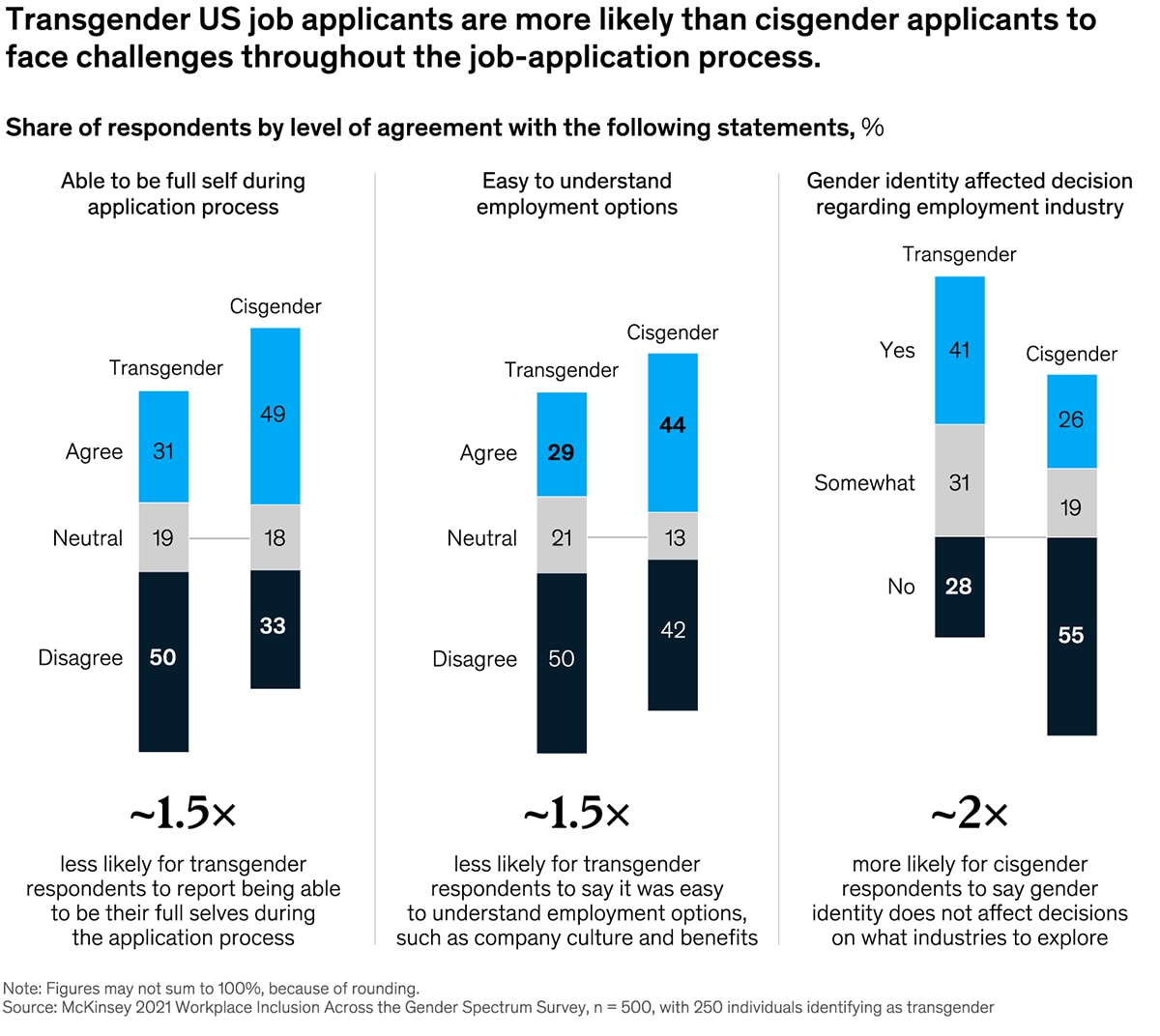
See more 



This week’s other select charts More women in the workforce: Key to higher GDP in CEE Patently inferior? Bailing for better benefits Driven by climate change 

Follow our thinking 



Share these insights Did you enjoy this newsletter? Forward it to colleagues and friends so they can subscribe too.
Was this issue forwarded to you? Sign up for it and sample our 40+ other free email subscriptions here.This email contains information about McKinsey’s research, insights, services, or events. By opening our emails or clicking on links, you agree to our use of cookies and web tracking technology. For more information on how we use and protect your information, please review our privacy policy. You received this email because you subscribed to The Week in Charts newsletter. Manage subscriptions | Unsubscribe Copyright © 2022 | McKinsey & Company, 3 World Trade Center, 175 Greenwich Street, New York, NY 10007
by "McKinsey Week in Charts" <publishing@email.mckinsey.com> - 03:29 - 22 Jan 2022 -
Having difficulty keeping your employees?
McKinsey&Company
Maybe your workplace environment is the problem .
Share this email 



McKinsey Classics | January 2022 
Having difficulty keeping your employees? The job market will probably continue to be a challenge for employers in the new year, which means that your workplace—whether remote or in-person—needs to be as comfortable, collaborative, and welcoming as possible if you are to retain workers. So what is your company’s culture like? Do people in your office—or you yourself—explode at meetings? Make sarcastic jokes about employees? Interrupt them when they are presenting? Treat them as if they were invisible? Send them withering e-mails? Scold them publicly? If so, you have a workplace jerk problem. Fifteen years ago, we published an article about workplace jerks—particularly managers and executives—by Robert Sutton, a management professor at Stanford. One psychologist whose work Sutton describes asked the subjects of a study whether and how their bosses behaved abusively. Six months later, he found that employees with abusive supervisors quit their jobs at higher rates; those who remained were less committed to their companies and more prone to burnout. Many other studies have similar findings. One story Sutton tells, about a 36-year-old man humiliated in public by his boss, is painful to read. But you owe it to yourself and your employees to think about our 2007 classic “Building the civilized workplace.” — Roger Draper, editor, New York Don’t be a jerk 



Related Reading 
Rudeness on the rise 

Well-being in the workplace 

Being a good boss isn’t easy—here’s how to get better 

Did You Miss Our Previous McKinsey Classics? 

Starting up as CFO What do CFOs do upon taking office? In retrospect, what do they think they should have done? Read our 2008 classic article “Starting up as CFO.” Learn to think like a CFO 





Follow our thinking 


McKinsey Insights - Get our latest
thinking on your iPhone, iPad, or Android

This email contains information about McKinsey’s research, insights, services, or events. By opening our emails or clicking on links, you agree to our use of cookies and web tracking technology. For more information on how we use and protect your information, please review our privacy policy. You received this email because you subscribed to our McKinsey Classics newsletter. Manage subscriptions | Unsubscribe Copyright © 2022 | McKinsey & Company, 3 World Trade Center, 175 Greenwich Street, New York, NY 10007
by "McKinsey Classics" <publishing@email.mckinsey.com> - 11:43 - 22 Jan 2022 -
Esto debería ser lo más importante en la agenda del CEO en 2022
McKinsey&Company
Además, la variante de Ómicron, el estado de la banca global y más .
Comparte este email 



Destacados mensuales, enero de 2022 En los primeros días del año que comienza, el entorno empresarial sigue siendo complejo, incierto y se encuentra en rápida evolución. En los meses y años venideros, las compañías necesitarán resiliencia para navegar las crisis y agilidad para aprovechar las nuevas oportunidades. La responsabilidad recaerá en la persona en la que todos confían como catalizador del cambio: el CEO. Este mes, nuestras historias destacadas analizan cómo está cambiando la agenda de los CEOs a medida que persisten los problemas relacionados con las operaciones, así como la mentalidad que ayuda a los mejores CEOs a lograr un impacto extraordinario. Otros temas destacados en el número de este mes son los siguientes: - La variante de Ómicron y lo que nos depara
- El estado de la banca global y lo que puede marcar la diferencia en los resultados a largo plazo
- Cómo se espera que se comporte la industria de la moda en 2022
- Por qué abordar las barreras que impiden que los latinos se integren plenamente en la economía estadounidense presenta una oportunidad para que la economía sea más sólida para todos
La selección de nuestros editores 

El CEO: Arquitecto de la nueva agenda de operaciones Para prosperar en una economía pospandémica volátil e impredecible, las compañías necesitan operaciones empresariales más inteligentes, rápidas y ágiles. Esto requiere grandes cambios y el compromiso de la cúpula de la organización. 3 imperativos operativos 





Author Talks: ¿Qué separa a los mejores CEOs del resto? Tres socios sénior de McKinsey analizaron más de 20 años de datos sobre 7,800 CEOs de 3,500 empresas públicas de 70 países y 24 sectores para identificar la mentalidad que ayudó a los altos ejecutivos a lograr un impacto extraordinario. Busque la excelencia 




LOS DESTACADOS DE ESTE MES 
¿Cuándo terminará la pandemia de la COVID-19? La variante Ómicron se está expandiendo rápidamente. ¿Qué nos depara? Nuestro análisis ofrece algunos escenarios para comprender los posibles resultados. También examinamos los efectos de las vacunas de refuerzo, la posible disminución de la eficacia de las vacunas y las nuevas terapias orales. Vea la actualización 

Informe anual de la banca global en 2021: La gran divergencia La brecha de valoración entre las instituciones bancarias líderes y las que van a la zaga se está ampliando una vez más. Las decisiones que se tomen en los próximos 18 a 24 meses determinarán qué firmas saldrán del lado correcto de esta divergencia. Lea el informe 

El estado de la moda 2022: Una recuperación desigual y nuevas fronteras En 2022, la industria de la moda puede volver a crecer, ya que los cambios en el panorama de las categorías, las nuevas fronteras digitales y los avances en sostenibilidad continúan presentando oportunidades. Súbase a la tendencia 
La situación económica de los latinos en Estados Unidos: El sueño americano aplazado Hacer frente a las barreras que impiden la plena participación económica de los latinos podría tener un impacto multibillonario al dar rienda suelta a su espíritu emprendedor, crear millones de puestos de trabajo, impulsar el gasto de los consumidores y generar riqueza intergeneracional. Descargue el informe completo 

Perder desde el primer día: Por qué incluso las transformaciones exitosas se quedan cortas Nuestra última investigación sobre transformaciones confirma que el éxito sigue siendo difícil de alcanzar y depende de un enfoque holístico. Sin embargo, algunas acciones son especialmente predictivas de la realización de los beneficios financieros en juego. Supere las dificultades 

Informe global 2021: El estado de la creación de nuevas empresas Los líderes empresariales prevén que, para 2026, la mitad de sus ingresos procederá de productos, servicios o negocios que aún no se han creado. Esta es la manera en que el desarrollo de nuevas empresas puede ayudar a reducir esa brecha mediante un crecimiento sostenible e incluyente. Vea los resultados Esperamos que disfrute de los artículos en español que seleccionamos este mes y lo invitamos a explorar también los siguientes artículos en inglés. 
ALSO NEW 2021 turning point: Reinvention and opportunity in the economy of the future Married to the job no more: Craving flexibility, parents are quitting to get it Pop quiz: Can you turn attrition into attraction? Quantum computing use cases are getting real—what you need to know America 2022 in charts: An economic opportunity snapshot The economic state of Latinos in America: The American dream deferred Black consumers: Where to invest for equity (a preview) Author Talks: Why burnout is an epidemic—and what to do about it Navigating the labor mismatch in US logistics and supply chains 
YEAR IN REVIEW: OUR TOP INSIGHTS IN 2021 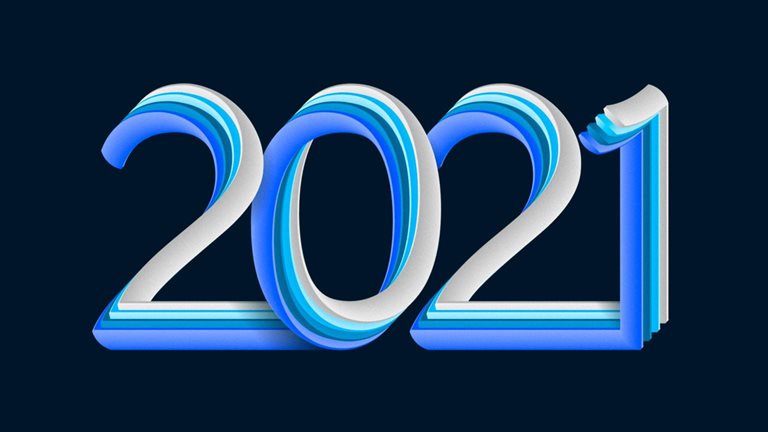
2021 year in review: Envisioning sustainable, inclusive growth Explore McKinsey’s most popular, innovative insights from a year of tremendous change—2021’s top articles and reports, charts, images, podcasts, webinars, newsletters, and more. See more 

2021: The year in charts Here’s a look back at some of our favorite data visualizations from our Charting the Path to the Next Normal series. Dive deeper on data 

2021: The year in images The year’s defining moments offer insight into the elements that drive, unite, and inspire us as we face the future. Look closer 
SPECIAL FEATURES 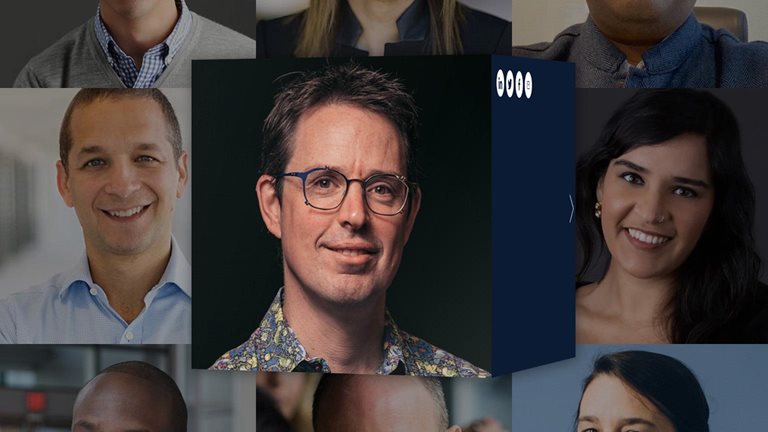
What’s to come in media Journalists, media executives, columnists, commentators, and media critics offer perspectives on what will make the news in 2022. See their responses 

McKinsey for Kids Explore K-pop, culture, shipping containers, and Asia’s key role in the global economy. Let’s go 

Author Talks Explore our latest conversations with authors of books on business and beyond. Get smart 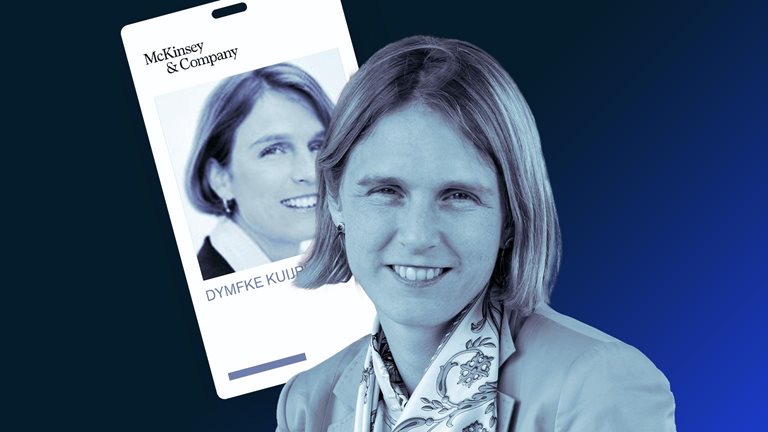
My Rookie Moment McKinsey senior colleagues share their formative early-career experiences to help you navigate yours. Watch 

McKinsey Classics What do CFOs do upon taking office? In retrospect, what do they think they should have done? Read “Starting up as CFO.” Rewind 
Readers & Leaders Read a sample of Readers & Leaders and sign up for it or any of our 40+ free email subscriptions. Subscribe — Curated by Eleni Kostopoulos, a manager of digital publishing in McKinsey’s New York office 

Follow our thinking 


McKinsey Insights - Get our latest
thinking on your iPhone, iPad, or Android


Comparta estas ideas ¿Disfrutaste este boletín? Reenvíelo a colegas y amigos para que ellos también puedan suscribirse.
¿Se le remitió este articulo? Regístrese y pruebe nuestras más de 40 suscripciones gratuitas por correo electrónico aquí.Este correo electrónico contiene información sobre la investigación , los conocimientos, los servicios o los eventos de McKinsey. Al abrir nuestros correos electrónicos o hacer clic en los enlaces, acepta nuestro uso de cookies y tecnología de seguimiento web. Para obtener más información sobre cómo usamos y protegemos su información, consulte nuestra política de privacidad. Recibió este correo electrónico porque es un miembro registrado de nuestro boletín informativo Destacados. Manejar suscripciones | Cancelar Copyright © 2022 | McKinsey & Company, 3 World Trade Center, 175 Greenwich Street, New York, NY 10007
by "Destacados de McKinsey" <publishing@email.mckinsey.com> - 08:43 - 22 Jan 2022 -
Build the cloud talent you need—these 6 actions can help
the Daily read
Capture more value .
Share this email 



AN ARTICLE A DAY, PICKED BY OUR EDITORS 
Investment in cloud transformations tripled between 2017 and 2021—but companies haven’t matched that frenetic pace on the talent front. And cloud is a crucial battleground for tech talent, especially given there’s more than $1 trillion of new value at stake. A new article lays out six practical actions to build your talent bench. Check it out. — Torea Frey, managing editor, Seattle 
Six practical actions for building the cloud talent you need Despite a shortage of cloud talent, top companies are finding ways to get past table stakes and build the capabilities needed. Capture more value 

Quote of the Day “Great CEOs are bold. You can be bold regardless of context. Or you can be bold within that context. If you’re not bold in that first year, you’re not going to move the needle. That is the crux that’ll actually let you conquer any context and any situation around failing. That is your one safeguard against failure.” —Senior partner Vik Malhotra, coauthor of forthcoming McKinsey book CEO Excellence, in a conversation on what separates the best CEOs from rest from McKinsey’s Author Talks series 
Chart of the Day See today’s chart 
Also New 

The powerful role financial incentives can play in a transformation Generous and specific financial incentives can help drive and sustain a rapid performance improvement. Seven principles can assist in delivering the maximum benefit during a transformation. Increase the odds 


Risk and resilience in consumer-goods supply chains Consumer-goods makers’ supply chains are weathering enormous strain. Here’s a quick look at how to strengthen them for the future. Adapt to change 


The McKinsey Crossword: World Economic Forum | No. 59 Sharpen your problem-solving skills the McKinsey way, with our weekly crossword. Each puzzle is created with the McKinsey audience in mind, and includes a subtle (and sometimes not-so-subtle) business theme for you to find. Answers that are directionally correct may not cut it if you’re looking for a quick win. Play now 


Follow our thinking 



Share these insights Did you enjoy this newsletter? Forward it to colleagues and friends so they can subscribe too.
Was this issue forwarded to you? Sign up for it and sample our 40+ other free email subscriptions here.This email contains information about McKinsey’s research, insights, services, or events. By opening our emails or clicking on links, you agree to our use of cookies and web tracking technology. For more information on how we use and protect your information, please review our privacy policy. You received this email because you subscribed to the Daily Read newsletter. Manage subscriptions | Unsubscribe Copyright © 2022 | McKinsey & Company, 3 World Trade Center, 175 Greenwich Street, New York, NY 10007
by "McKinsey Daily Read" <publishing@email.mckinsey.com> - 06:16 - 21 Jan 2022 -
As we round year three, burnout is high. Here's how organizations can help.
Leading Off
Plus, Microsoft goes big on gaming .
Share this email 



Our best ideas, quick and curated | january 21, 2022 View in browser 
This week, the perils of work burnout and how best to address it. Plus, mobility sees a rebound, and Tech for Execs on how leaders can get up to speed on “continuous integration and continuous delivery,” or CI/CD. 
Running on fumes. We’re entering year three of the global pandemic, as readers most assuredly are aware. We’ve brought you articles about ways people and organizations can be more resilient and adaptable. We’ve written about the crucial need for wellness and mental health. But even though we’d all love to move on from pandemic affairs, it’s important to address one factor taking its toll on workers and organizations around the globe: burnout. Whether you’re still working from home or went back to in-person work right away, burnout may have been a constant companion for you or others in your organization. It’s chronic. The WHO defines occupational burnout as a syndrome, resulting from chronic workplace stress, that’s characterized by exhaustion or lack of energy, negative or cynical feelings associated with work, and reduced effectiveness in a role. As the world continues to grapple with the COVID-19 crisis, the emotional and psychological response to extended periods of pandemic-related uncertainty could significantly affect social and economic recovery efforts. Learned healthfulness. The good news is that psychological resilience can be learned, and research shows that people who report higher levels of resilience are physically healthier, more productive, and happier. McKinsey recently spoke with Amit Sood, MD, a leading expert on psychological resilience, about how people can tap into that mindset, strategies for maintaining well-being, and what companies can do to support their workers. He believes that employers have to view mental and behavioral health holistically, emphasizing prevention, treatment, and rehabilitation. Instead of focusing on productivity, he says, focus on purpose, cultivate compassion, and give employees the agency to make decisions. “It’s important to keep in mind what makes employees tick,” he said. “What really keeps them going is a sense of control and a sense of purpose. And if you give them both, it can help combat the cognitive overload that we may all be feeling.” Wish fulfillment. On the individual level, he suggests having realistic expectations of others too. “We have a practice called ‘kind attention,’ where you assume that everybody is struggling in some form or another,” he says. Replacing judgment with empathy, even before you get to know someone—“a silent good wish,” as he calls it—can kick off new relationships with a stronger connection. Good gossip. Jennifer Moss, the author of The Burnout Epidemic: The Rise of Chronic Stress and How We Can Fix It and member of the Global Happiness Council, told McKinsey recently that organizations need to look beyond traditional wellness perks to solve burnout. One way is to create “positive gossip,” which fosters a type of social contagion that creates positive narratives; think about complimenting a colleague on a recent presentation, for example. That positive feedback creates “this contagion effect—this network effect—of high productivity, high sense of self-efficacy, and value. Every boat is lifted when we behave that way.” Care for caregivers. Traditional wellness perks may also fall short for a large high-burnout group: working parents. As a recent survey of employed parents in the US indicates, the compound pressure of working while parenting has not only left many people feeling apathetic and fatigued but also created a sense of failure to live up to their own expectations as employee, parent, spouse, friend, or caregiver. Parents disproportionately left jobs over the past several months, according to our research on the Great Attrition. Call and response. Women in particular are facing higher long-term burnout and stress levels, as demonstrated by this honest conversation with three McKinsey senior partners—two mothers and one father, who took time off to be with his young daughter. One note of optimism, they said, was that we now have a fact base of real and measured experiences that companies can’t hide from and that the most responsive don’t want to hide from. Organizations that wish to retain these workers need to move quickly; in this recent article, we look at focused responses, which include crafting jobs that offer radical flexibility, providing more creative childcare support, and leaving the door open for parents who have left jobs but may want to return. 
OFF THE CHARTS The thin grid line Extreme weather events are taking a toll on electric grids. Modeling climate change resilience can provide valuable insights when and where they’re needed most. In the case of extreme wind, the direct effects include the impact of high winds on power lines, while the indirect effects include the disruption of nongrid assets such as power plants. Vulnerability curves express the probability of asset failure as a function of the intensity of the weather event. As the latter increases, so too does the probability of failure. 
Check out our chart of the day here. 

INTERVIEW ‘To play is fundamentally human’ It’s been a long road for Microsoft’s gaming business since the launch of the first Xbox console in 2001. Rather than selling its gaming business, as some Wall Street analysts had urged, Microsoft doubled down and shifted from a console-centric approach toward a “ubiquitous global gaming ecosystem.” Its recently announced plan to purchase Activision Blizzard, the game maker behind Call of Duty and Candy Crush, is part of this strategy to compete in the traditional online gaming world as well as in virtual and augmented reality. McKinsey recently chatted with Sarah Bond, corporate vice president for game creator experience and ecosystem at Xbox, about how what happens in gaming translates to other industries. 
MORE ON MCKINSEY.COM Mobility rebounds, but where is it headed? | Mobility has reached precrisis levels again in many regions of the world. But the mobility preferences of consumers, including which modes of transport they choose, will look different in 2022 and beyond, mostly because of workplace shifts. Space: The final R&D funding frontier | We examined data for R&D spending to identify important financing trends, including how commercial-sector contributions to space-sector R&D have scaled and how they compare with government contributions. India’s logistics sector needs to focus on technological change | The failure of most logistics functions to use best practices, and the lack of coordination and collaboration between the warehousing and transport functions, are two top pain points. Digital tools can change that. 

TECH FOR EXECS Are your application releases and updates continuous? Our experts serve up a periodic look at the technology concepts leaders need to understand to help their organizations grow and thrive in the digital age. What it is. Continuous integration and continuous delivery mean the practice of developing software applications in a fast, agile, and highly automated fashion. Today’s increasingly complex software applications require various developers to write different parts of an application. Continuous integration automates bringing those parts together and regularly merging and testing them to ensure that everything still works as expected. In continuous delivery, the application is built automatically and then put into a staging environment (an area set up just like the one the app will inhabit when live, though it actually isn’t live at this stage). Then, with just the click of a button, someone can send an application or update into the world. CD sometimes also stands for “continuous deployment,” which means that the application or update pushes out automatically rather than requiring someone to “hit the switch.” Why it’s essential. Back in the day (less than 20 years ago in these times of accelerated digital change), software applications were created using a waterfall approach—every step in the process took place only after the previous step was completed. As a result, it could take many months or years to develop and deploy (or release) an application. That snail’s pace doesn’t fly in today’s world, where applications power so many consumer and business activities, and developers must continually refresh the software to expand or upgrade its capabilities. Of course, you can’t sacrifice quality for speed—the automated testing in CI/CD ensures quality, and at a much faster pace than manual checks require (you can include some manual checks in the process if you like). CI/CD is a critical part of DevSecOps, the whole set of tools, practices, and philosophies involved in creating great applications quickly and securely, as well as MLOps, which takes the tenets of DevOps and applies them to the creation of AI applications powered by machine learning; these apps are now used by a majority of businesses. What the benefits are. It doesn’t take much explanation to see why you’d want your applications to be developed quickly, work correctly, and reach customers or internal users promptly. However, besides making users happy and staying ahead of the competition, these techniques also make your developers more productive and will help you attract the cream of the crop because they want to be more productive and spend less time doing tedious work. The fine print. Putting CI/CD in place isn’t just a matter of hooking up to the cloud and saying “Go!” to your developers. It requires cultural change and knowledge of agile practices to ensure that you’re not only hiring new talent with CI/CD experience but also upskilling your current developers. — Edited by Barbara Tierney Share this Tech For Execs 



BACKTALK Have feedback or other ideas? We’d love to hear from you. 
Tell us what you think 

Follow our thinking 



Share these insights Did you enjoy this newsletter? Forward it to colleagues and friends so they can subscribe too.
Was this issue forwarded to you? Sign up for it and sample our 40+ other free email subscriptions here.This email contains information about McKinsey’s research, insights, services, or events. By opening our emails or clicking on links, you agree to our use of cookies and web tracking technology. For more information on how we use and protect your information, please review our privacy policy. You received this email because you subscribed to The Shortlist newsletter. Manage subscriptions | Unsubscribe Copyright © 2022 | McKinsey & Company, 3 World Trade Center, 175 Greenwich Street, New York, NY 10007
by "McKinsey Shortlist" <publishing@email.mckinsey.com> - 02:04 - 21 Jan 2022 -
Hello from Hazelcast
Hi Mr.Abul,
Thank you for your interest in Hazelcast.
I can see that you have recently registered for a course at our training center and wanted to get in touch to see if we could be of any further assistance.
Would you like to speak with one of our solution architects to get a clearer understanding of Hazelcast's In-Memory platform or is there anything else we can help you with?
Kind regards,
Patavipron RitaBusiness Development ExecutiveHAZELCAST
This message contains confidential information and is intended only for the individuals named. If you are not the named addressee you should not disseminate, distribute or copy this e-mail. Please notify the sender immediately by e-mail if you have received this e-mail by mistake and delete this e-mail from your system. E-mail transmission cannot be guaranteed to be secure or error-free as information could be intercepted, corrupted, lost, destroyed, arrive late or incomplete, or contain viruses. The sender therefore does not accept liability for any errors or omissions in the contents of this message, which arise as a result of e-mail transmission. If verification is required, please request a hard-copy version. -Hazelcast
by "Marketing East Asia" <marketing_eastasia@hazelcast.com> - 11:07 - 19 Jan 2022 -
[Live Demo Series] One platform. Many use cases.
Sumo Logic
Application Mondernization and Modern Security Live Demos
 Hello Mohammad,
Hello Mohammad,
Don’t miss this live demo and Q&A series on mastering your data! All demos are 30 minutes with a live Q&A. See the features you want to use in action and get instant answers to your questions.
Cloud Security Monitoring and Analytics, January 27th at 12pm AEST Companies generate data at an exponential rate, and the task of analyzing customer data to produce relevant security analytics insights can be overwhelming. The Sumo Logic cloud-native platform provides granular visibility at cloud scale that empowers your team to prioritize and investigate security insights within your infrastructure. Register Cloud SIEM, January 28th at 12pm AEST Sumo Logic’s Cloud SIEM solution provides security analysts with enhanced visibility to seamlessly monitor their organisation’s on-prem, hybrid, and multi-cloud infrastructures. By collecting and automatically correlating all of their data, Sumo Logic’s Cloud SIEM detects threats and enables SOC teams to thoroughly understand the impact and context of an attack. Register Application Observability, February 1st at 12pm AEST Demand for faster innovation and efficiency is driving organisations to accelerate application modernisation creating additional challenges on how to manage their reliability. Sumo Logic’s observability solution gives site reliability engineers operational visibility across the entire stack, with entity-driven correlations and actionable insights from your applications to your infrastructure. Register Software Development Optimization, February 2nd at 12pm AEST Boost your software development lifecycle with Sumo Logic’s solution created to help teams build better software faster. The Software Development Optimization solution is designed to collect and correlate data across the entire software development process and DevOps toolchain to help teams continuously improve how they deliver software. Register Cloud SOAR, February 3rd at 12pm AEST Sumo Logic’s Cloud SOAR boosts the effectiveness of security analysts by providing automated real-time incident management responses, immediate and customisable incident reports, and invaluable insights regarding incoming alerts, ultimately enhancing the accuracy and speed at which SOC teams respond to threats. Register Sumo Logic, Level 9, 64 York Street, Sydney, NSW 2000
© 2022 Sumo Logic, All rights reserved.Unsubscribe 


by "Sumo Logic" <marketing-info@sumologic.com> - 07:01 - 19 Jan 2022 -
[Live Webinar] How to Create an Optimized API Development Process
Join to learn some of best practices in API development.Hi there,
Successful digital strategies rely on delivering quality and consistent APIs. To do so, you need an integrated and optimized API development workflow that ensures quality while improving efficiency.
With SmartBear, customers can launch a scalable API program with a central platform for OpenAPI standards, API design, and collaboration, coupled with a single UI for functional, performance, and security testing. With our full suite of API development and testing tools, you can deliver high-quality APIs at speed and scale.
As leaders in API Development, we’ve shown thousands of API developers and testers new and exciting ways to build efficiency and scale into their API development processes.
Join us on January 20th for this informative session as we review some best practices in API development where you’ll learn how to:- Enforce API standards across your organization
- Reduce API development time and effort
- Improve overall API quality
How to Create an Optimized API Development Process
Live TOMORROW! January 20th
Can't make the live session? Register and we will send you the recording!
We hope you can join us,
Stephanie
This email was sent to info@learn.odoo.com by SmartBear Software, 450 Artisan Way, Somerville, MA. 02145, 617.684.2600, www.smartbear.com. We hope you found this email of interest. However, we value your privacy. Please click here to Unsubscribe or manage mail preferences. Privacy Policy.
by "Steph from SmartBear" <readyapi-team@smartbearmail.com> - 01:06 - 19 Jan 2022 -
Reducing Redundancy with Reusable Domains| The SmartBear Designer Series
Join us on Jan. 25th to learn about domain reusabilty in SwaggerHubHey Abul,
Hope to see you there,
Next Tuesday, we are hosting our next installment of "The Designer Series", our monthly tutorial to highlight a specific SwaggerHub use case. For this upcoming session, we are focusing on how you can leverage reusable domains in SwaggerHub to ensure standard, consistent API design.
With SwaggerHub's domain reusability, your development team can streamline production, eliminate duplicate efforts, and centralize the repository of approved design requirements.
To join us for this session, you can register here: "The Designer Series: Reducing Redundancy with Reusable Domains"
Andrew Marotta,
Senior Marketing Specialist at SmartBear
P.S. If you can't attend but are interested in watching, just register and we will send you the recording after.
This email was sent to info@learn.odoo.com by SmartBear Software, 450 Artisan Way, Somerville, MA. 02145, 617.684.2600, www.smartbear.com. We hope you found this email of interest. However, we value your privacy. Please click here to Unsubscribe or manage mail preferences. Privacy Policy.
by "Andrew from SmartBear" <swaggerhub-team@smartbearmail.com> - 01:13 - 18 Jan 2022 -
[Blog] Should your developers learn Kubernetes?
[Blog] Should your developers learn Kubernetes?
Kubernetes, developed by Google, automates the deployment & orchestration of your applications with the help of a powerful, extensible API.Hi MD Abul
When you create an application, you need to decide how best to deploy it to your users. If you choose to containerize the application, the server could get overloaded and users might not be able to access it during high server traffic or server downtime.
You could choose to deploy the application on multiple hosts so that if one goes down others are still accessible. However, deploying an application on multiple connecting containers across multiple hosts, scaling them, and managing them can be a complex task.
Kubernetes is a feasible alternative. This open-source platform developed by Google automates the deployment and orchestration of your applications with the help of a powerful, extensible API.In our latest blog post, we examine the pros and cons of Kubernetes, so you can determine whether it’s the solution for your team. Check it out and let us know what you think.
Best wishes,
Tyk, 22 Technology Parkway, Atlanta, Georgia GA 30092, USA, +1 (404) 4511123
by "Budhaditya Bhattacharya" <budha@tyk.io> - 02:59 - 17 Jan 2022 -
[Live Webinar] How to Create an Optimized API Development Process
Join to learn some of best practices in API development.Hi there,
Successful digital strategies rely on delivering quality and consistent APIs. To do so, you need an integrated and optimized API development workflow that ensures quality while improving efficiency.
With SmartBear, customers can launch a scalable API program with a central platform for OpenAPI standards, API design, and collaboration, coupled with a single UI for functional, performance, and security testing. With our full suite of API development and testing tools, you can deliver high-quality APIs at speed and scale.
As leaders in API Development, we’ve shown thousands of API developers and testers new and exciting ways to build efficiency and scale into their API development processes.
Join us on January 20th for this informative session as we review some best practices in API development where you’ll learn how to:- Enforce API standards across your organization
- Reduce API development time and effort
- Improve overall API quality
How to Create an Optimized API Development Process
Live on January 20th
Can't make the live session? Register and we will send you the recording!
We hope you can join us,
Stephanie
This email was sent to info@learn.odoo.com by SmartBear Software, 450 Artisan Way, Somerville, MA. 02145, 617.684.2600, www.smartbear.com. We hope you found this email of interest. However, we value your privacy. Please click here to Unsubscribe or manage mail preferences. Privacy Policy.
by "Steph from SmartBear" <readyapi-team@smartbearmail.com> - 01:07 - 12 Jan 2022 -
The Tyk Times: What it's like working at Tyk and more
The Tyk Times: What it's like working at Tyk and more
Employees reveal what it's like working at Tyk. We celebrate Community Award winners, chat about monetisation and migrating from Tyk to KongEmployees reveal 8 things they love about Tyk
No company would ever aspire to be a rubbish place to work. Yet not every business gets it right when it comes to delivering the ideal working environment. We think Tyk is doing pretty well in this respect. However, you can only really judge what an organisation is like to work for by the views of its staff.
That’s why, when we started thinking about working life at Tyk, we decided to talk to the people in the know – our global team of Tyklings. We asked them to give us the insider’s perspective – a no holds barred view of what it’s really like to work at Tyk.
API Monetisation Strategies
When you’re building an API, you need to create a management strategy that maximises its potential. Monetisation is a key part of that.
There are multiple ways to make money from your API. In this article, you’ll learn about your options and when best to use each of them. Many of these options can be used concurrently, so even if you have an existing strategy, you may be able to incorporate the others.
Migrating your open source API gateway from Kong to Tyk
Why might you be considering moving from Kong to Tyk? In all likelihood, it’s because you need to do something that you can’t manage with the open source version of Kong.
Whatever your reason, Tyk’s “batteries included” approach means that our free, open source gateway can achieve what you need, straight out of the box. Let’s dive into the detail…
Hearty congratulations to Tyk Community Award winner Darkweak!
Yes, it’s that special time of year again! Time to roll out the virtual red carpet and congratulate the winners of the Tyk Community Awards. The Tyk Community Awards are Tyk’s chance to reach out and recognise outstanding contributions within the open source community.
They’re our chance to highlight contributors who have gone above and beyond – contributors like Darkweak. Our excitement centres around Souin, Darkweak’s new Open Source caching tool, and its integration with Tyk. Read on to find out more about it.
Tyk, 87a Worship Street, London, City of London EC2A 2BE, United Kingdom, +44 (0)20 3409 1911
by "Martin Buhr" <martin.buhr@tyk.io> - 09:16 - 11 Jan 2022 -
[Live Demo Series] Thrive in the Intelligence Economy
Sumo Logic
Live Demo Series
 Hello Mohammad,
Hello Mohammad,
Don’t miss this live demo and Q&A series on mastering your data! All demos are 30 minutes with a live Q&A. See the features you want to use in action and get instant answers to your questions.
Cloud Security Monitoring and Analytics, January 27th at 12pm AEST Companies generate data at an exponential rate, and the task of analyzing customer data to produce relevant security analytics insights can be overwhelming. The Sumo Logic cloud-native platform provides granular visibility at cloud scale that empowers your team to prioritize and investigate security insights within your infrastructure. Register Cloud SIEM, January 28th at 12pm AEST Sumo Logic’s Cloud SIEM solution provides security analysts with enhanced visibility to seamlessly monitor their organisation’s on-prem, hybrid, and multi-cloud infrastructures. By collecting and automatically correlating all of their data, Sumo Logic’s Cloud SIEM detects threats and enables SOC teams to thoroughly understand the impact and context of an attack. Register Application Observability, February 1st at 12pm AEST Demand for faster innovation and efficiency is driving organisations to accelerate application modernisation creating additional challenges on how to manage their reliability. Sumo Logic’s observability solution gives site reliability engineers operational visibility across the entire stack, with entity-driven correlations and actionable insights from your applications to your infrastructure. Register Software Development Optimization, February 2nd at 12pm AEST Boost your software development lifecycle with Sumo Logic’s solution created to help teams build better software faster. The Software Development Optimization solution is designed to collect and correlate data across the entire software development process and DevOps toolchain to help teams continuously improve how they deliver software. Register Cloud SOAR, February 3rd at 12pm AEST Sumo Logic’s Cloud SOAR boosts the effectiveness of security analysts by providing automated real-time incident management responses, immediate and customisable incident reports, and invaluable insights regarding incoming alerts, ultimately enhancing the accuracy and speed at which SOC teams respond to threats. Register Sumo Logic, Level 9, 64 York Street, Sydney, NSW 2000
© 2022 Sumo Logic, All rights reserved.Unsubscribe 


by "Sumo Logic" <marketing-info@sumologic.com> - 07:01 - 11 Jan 2022


